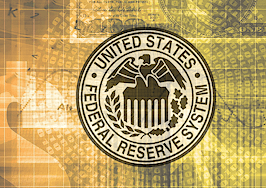Last week was quiet, eh?
In financial markets — that was certainly so, as the great freeze continues. The mortgage-driving 10-year T-note stayed in a band 2.14-2.21 percent (too tight to call it a “range”), leaving mortgages unchanged near 4.00 percent. The stock market is even deader, the S&P500 trading between 2426 and 2438.

The US 10-year T-note in the last year, wobbling down.
Make sense of this. All in one week we had: James Comey (written testimony and also live), the U.K. in chaos (Brexit backlash, Theresa May not long for office), the Gulf states’ dangerous spat with Qatar (a Middle East crisis) and falling oil prices.
Maybe none of this matters to markets, or it’s all too overwhelming to process?

The US 2-year T-note, the Fed-predictor — grudgingly rising.
Maybe the frozen U.S. economic agenda has iced markets?
Or maybe we’re all just sitting around, waiting for the Fed on Wednesday.
Data from the Fed
This week’s only meaningful economic data came from the Fed, its quarterly Z.1 Financial Accounts of the U.S. — 198 pages detailing the flow and landing place of every dollar in the financial system. In real estate we care only about two of those pages: mortgage markets.
This new Z.1 is reassuring. We need enough credit, but not too much. Total U.S. home mortgage balances increased in the first quarter at an annual rate of 1.8 percent — write-offs of old trash still offsetting a chunk of new production.

Inflation should be rising as unemployment falls, and it’s not.
In dollars, the total gain was $44 billion, but the center of write-offs is still the old subprime loans in asset-backed securities, down $20 billion in the quarter — from $2.2 trillion in 2006 to only $503 billion now. Home equity lines of credit get a great deal of ink from worrywarts, but their outstanding balances are also still falling — from $1.1 trillion at the peak, now $584 billion, down $11 billion in the quarter.
Growth in mortgage credit allowing for write-offs of old loans is still too slow to present any risk of a new bubble, or for that matter to provide cyclical power to the economy.

This week the Bureau of Labor Statistics found the largest number of un-filled job openings ever, and rising. So, employers are paying-up to attract talent? Not in a hyper-competitive world. Does it look a little weird to have more new un-filled openings than hires? Is there enough talent in the workforce to begin with? Not in dusty and emptying towns founded as centers of agricultural service or mining.
From there, straight to the Fed. Credit is not an issue. Overall economic growth is as-expected at about 2 percent annual. Inflation is not rising as expected to 2 percent, but nor are prices falling in any dangerous way. But the Fed is in crisis. Terrible, terrible trouble: its most important theory is broken.
The president or Congress in crisis? We must close our windows just to think. A theoretical crisis at the Fed? So quiet you can hear the laptop hard drives running math.
The Fed is caught in a crisis similar to cosmology: We can see the effects of dark matter and dark energy, or think we can, but we can neither find the stuff nor define it. In the Fed’s case, just the reverse: it has well-defined and visible theory, but it no longer does anything.
The Fed’s dark matter problem is the relationship between unemployment and wages and inflation. The original proposition is known as the “Phillips Curve” — long assumed, but defined by William Phillips in 1958: the lower unemployment, the higher inflation — and vice-versa in a recession.

Conclude with good news: 2nd Quarter GDP still on 3% annual track, and it’s only got three weeks to go.
Flash forward to 2012. Charles Evans, president of the Chicago Fed promulgated the “Evans Rule,” which said the Fed could and should keep the cost of money at 0 percent until unemployment fell below 6.5 percent, surely a dangerous threshold.
The Evans Rule became inconvenient in 2014, unemployment falling out from under the rule without effect on either wages or inflation. Since then, no Fed official has wished his or her name attached to a new rule.
Unemployment — now 4.3 percent — is on trend to fall to 3 percent-something by year-end.
Of the dozen-and-a-half Fed governors and regional presidents, about one-third have chained themselves to the old theory and want the Fed to march its rate ever-upward. The others indicate some suspicion, but for the most part have sense enough to discuss theory only in ways opaque to the public (where is r*, the neutral rate of interest, or NAIRU, the non-inflation accelerating rate of unemployment).
An antique measurement
The Phillips Curve was a reasonable guide for the Fed in the 20th Century. Times change. The very nature of work changes. We rely on aggregate measurements of an economy made up of 330 million souls and more integrated with the 7.2 billion outsiders every day.
Does the U.S. unemployment rate and its antique measurement have any forecasting utility today, or could it have become a statistical artifact, or an effect with limited causation?
If the Phillips Curve is toast, the Fed no longer has a leading indicator for inflation, just hocus-pocus theory of inflation “expectations.” What is to prevent ultra-easy money until inflation actually appears, possibly out of control? Or for that matter to prevent rigid old-thinkers from cratering a non-inflationary recovery because it used to be the right thing to do?
“This time is different” will get you laughed off any Wall Street stage. However, consider these unprecedented changes: Conditions in the countryside — Trump country — are painful and not improving. Migration from countryside to cities is devastating to the countryside.
The “skills mismatch” between those with technical skill and without is all around us, and probably the leading cause of migration. What does low unemployment matter if new hires are too poorly paid to contribute to inflation, and can’t protect themselves from the two US spikes in inflation, health care and higher education? And can’t be protected from low skill workers overseas?
Next Wednesday will be a big day for the Fed — but what it says will indicate more than the anticipated dinky rate-hike.
Lou Barnes is a mortgage broker based in Boulder, Colorado. He can be reached at lbarnes@pmglending.com.











